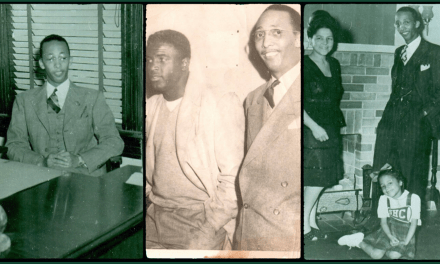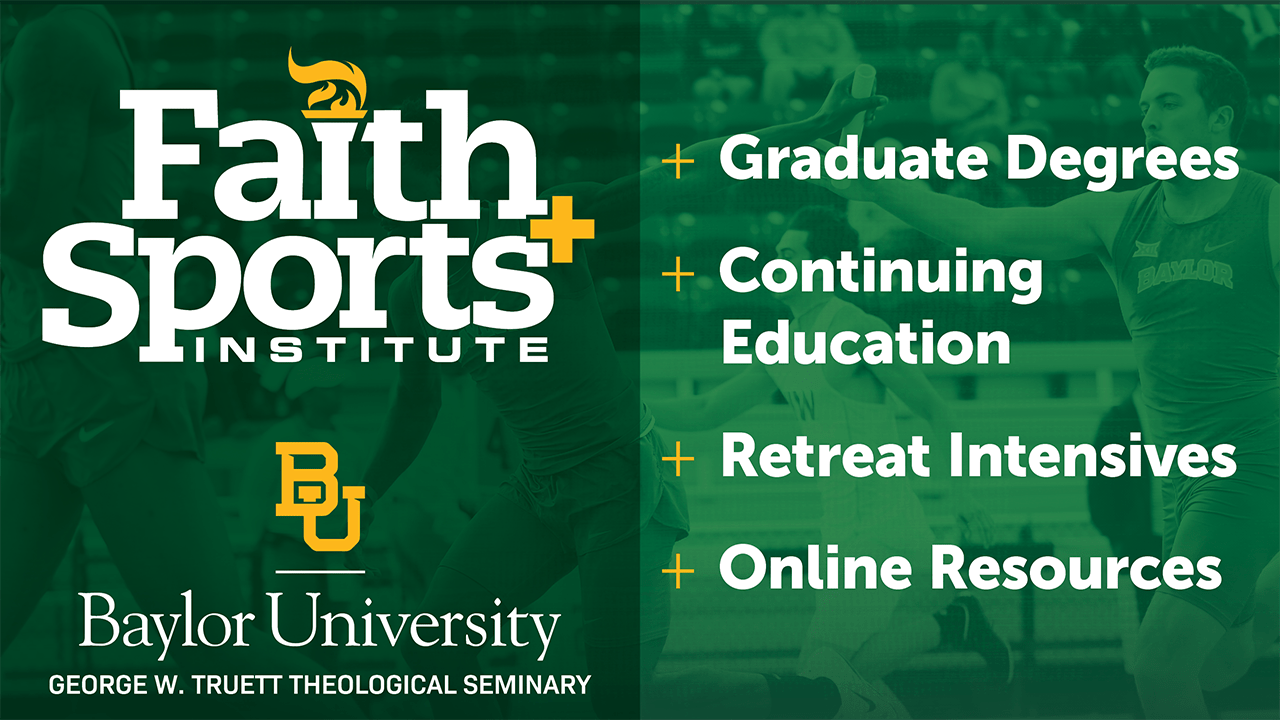
What does it mean to compete for Christ—to be a Christian athlete or coach? How should Christian athletes and coaches connect their faith with their participation in competitive athletics?
There have been a variety of approaches to those questions in the United States, each of them with their own unique strengths and weaknesses. Yet, there is rarely an understanding of where those ideas came from, historically or theologically. In this blog series, we’ll try to fill that gap by considering five main perspectives that have been influential in the American sports world—and particularly in sports ministry—for the past fifty years. Each of these five has been around since the 1970s, continuing to exert influence today.
Importantly, these five approaches are not mutually exclusive. Any Christian involved in sports ministry will likely encounter and perhaps even embrace ideas from several of these perspectives. At the same time, each approach provides a different framework and set of priorities for Christian sportspeople to consider as they compete. My hope is that by tracing the historical and theological roots of these five approaches, those of us in sports and sports ministry can reflect on and better understand our own ideas and practices, while gaining an appreciation for those who might come at it from a different angle.
First up: muscular Christianity.
Sports as Moral Formation
The foundation for Christian engagement in modern American sports is an ideology developed in the nineteenth century that scholars have labeled “muscular Christianity.”
There are plenty of academic books and articles written about muscular Christianity, but the key takeaway for our purposes is this: It sanctioned the physical activity of sports by giving it moral and religious value. Muscular Christians said that sports were not inherently sinful, nor were they simply entertainment and recreation; instead, sports could be a way to develop and grow Christian character. You could become a better Christian through sports participation.
Amos Alonzo Stagg, a pioneering football coach, embodied this perspective. A standout athlete at Yale in the 1880s, Stagg was originally going to be a minister. Instead, he pursued a career in coaching, deciding that he “could influence others to Christian ideals more effectively on the field than in the pulpit.”
What were those “Christian ideals” that Stagg sought to promote? For most muscular Christians, they were a constellation of traits connected to notions of strenuous masculinity and traditional middle-class American values: Cooperation, belief in God, initiative, self-discipline, loyalty, respect for authority, courage, honesty. If sports were properly regulated—kept free from the corrupting influence of money (for players at least)—then athletic participation could instill those values in the athletes who played the game.
This logic was grounded in a liberal Protestant understanding of the Christian faith. Instead of emphasizing God’s transcendence and the sinfulness of the world, it took an optimistic outlook on human culture, focusing on God’s immanence—it suggested that God was present and at work even through secular institutions, including properly regulated sports teams. The Christian faith was not so much about sinners in need of salvation, but seeds in need of nurturing and growth through the church as well as through family, school, and sports.
Amos Alonzo Stagg once again summarized this perspective: “Instead of going to church to learn how to live, the youngsters nowadays go anywhere they want to,” Stagg said. “Thank God, they like to go to football games! And the fellows who play and the men who coach them must realize that, in no small way, by their actions they are preaching sermons and laying down rules of conduct for the coming generation.”
As sports developed in the twentieth century, the ideology of muscular Christianity remained a central part of college and high school sports. It could be linked with women’s sports as well, but with women’s opportunities for competition severely limited, it was usually closely connected with men. Because it usually did not emphasize specific and particular Christian doctrines, it was malleable and broad, able to adapt to and accommodate a variety of religious perspectives.
This adaptability, however, could make it difficult to distinguish what was truly Christian about muscular Christianity and what was simply a broadly-shared vision of American life. One way that Christians countered this was by positioning Jesus as the exemplar of muscular Christian values, the ideal muscular Christian. Bruce Barton’s The Man Nobody Knows (1925) is the classic example of this approach. Barton’s best-selling book offered an up-to-date biography of Jesus that focused on his humanity and his leadership qualities. Jesus was the “founder of modern business” who possessed “muscles hard as iron” and “did not come to establish a theology but to lead a life.”
One reader who was inspired by Barton’s book explained its appeal this way: “My concept of a pale, meek and mild Jesus changed to one of a virile Man with great stamina.”
By positioning Jesus in this way, muscular Christians helped to make Jesus relevant to the world of modern sports. It was not much of a leap to go from Jesus as the ideal business executive to Jesus as the master coach. For many athletes and coaches, this understanding of Jesus provided a tangible and practical example for them to follow. By setting their eyes on Jesus as the “master coach,” their Christian character could grow through the sports they played and coached.
The Meaning of Success
There was one final element to the muscular Christian program that appealed to athletes and coaches: the notion of “true success.” It went like this: Instead of determining one’s worth and value through wins and losses—the results on the scoreboard—true success came from how one engaged in the process of competition.
In 1908, sportswriter Grantland Rice captured the essence of this idea with his famous lines:
For when the One Great Scorer comes to mark against your name
He writes—not that you won or lost—but how you played the Game.
These was no better representative of this muscular Christian formula than legendary basketball coach John Wooden. Growing up in Indiana in the 1920s, Wooden admired Amos Alonzo Stagg as the ideal coach, and he also drank deeply from the success literature that was popular at the time. When he became a coach himself, Wooden took those ideas and developed what eventually became known as the Pyramid of Success.
Wooden’s pyramid was essentially a collection of values that muscular Christians had advocated for earlier in the century: loyalty, cooperation, self-control, initiative, honesty, faith, and so on. By developing those character traits, Wooden suggested, athletes and coaches could achieve true success, which he defined as the “peace of mind, which is a direct result of self-satisfaction in knowing you did your best to become the best that you are capable of becoming.”
There were ironies and contradictions in this understanding of success. While it claimed that its focus was not on the scoreboard, it was almost always someone like Wooden—someone who had achieved a high level of scoreboard-determined success—who championed “true success” ideas. And yet, there is no doubt that it could also provide a deeply meaningful framework for coaches and athletes to maintain a healthy sense of perspective in their athletic pursuits.
Wooden’s connection to the legacy of muscular Christianity was apparent, too, in his ecumenical understanding of the Christian faith. Wooden was a follower of Christ, but he was not dogmatic about it.
“If you believe in a faith, if you feel in your heart it’s right for you, then I think it’s wonderful,” he told a reporter in 1974. “I don’t care what religion you have but have one.” For Wooden, the Golden Rule was the essence of all religions; if someone treated others as they wanted to be treated, Wooden said, “you’ll believe in the creator as I do.”
While Wooden, a lifelong member of the mainline Disciples of Christ denomination, generally held to liberal Protestant views, there was room for conservative theological perspectives within muscular Christianity as well. An evangelical who believed in the necessity of a supernatural conversion experience could easily add to their born-again convictions a belief in the value of the muscular Christian program. The difference was that someone like Wooden believed Christian faith could be nurtured and grown from birth as a person learned to follow and practice the ideals of the “master coach”; an evangelical, on the other hand, believed that a person had to be born again before their Christian faith could grow.
Black Perspectives
While muscular Christianity could be embraced across theological divides, it could also be adopted across the color line. When the ideology was first developed in the nineteenth century, it was closely linked with notions of White Anglo-Saxon superiority. In the 1920s, Amos Alonzo Stagg continued to articulate this belief. Asked why his team at the University of Chicago had never included a Black player, Stagg wrote that Black athletes were “less likely to be as good in that sport, where fearlessness, aggressiveness, and dogged determination play a large part in the selection of positions.” (Later in life, Stagg embraced more inclusive racial views).
Yet, Black leaders developed their own version of muscular Christianity that linked the development of Christian character through sports with the goal of breaking down racial barriers and cultivating Black dignity and pride.
Edwin Henderson, the “father of Black basketball”, is a good example of this. Henderson was a Baptist who worked with the YMCA in the early 1900s to organize basketball teams and leagues in Washington, D.C., all while linking his efforts with racial uplift. “The health and morals of our race may be improved through athletic recreation,” he wrote in 1912.
Throughout his life Henderson was also a fierce critic of racism, believing that integrated sports had the potential to break down racial barriers and “Christianize the hearts of men.” In his groundbreaking 1939 book, The Negro in Sports, Henderson wrote that sports could “develop a real Christian brotherhood among men of the minority and majority groups in our cosmopolitan American life.”
Another important Black muscular Christian was legendary Florida A&M football coach Jake Gaither. While White muscular Christians like Stagg believed young Black men lacked the leadership qualities necessary to excel in football, Black coaches like Gaither directly challenged those racist assumptions. As historian Derrick White explains, Gaither (and many others) saw college football as a way to cultivate “a version of Black manhood that tied student-athletes to the ideology of racial uplift and, eventually, to the mantle of racial leadership.”
In the 1920s, while he was a college athlete, Gaither wrote an article on the “benefits derived from football” that advocated for the “moral value in the game.” When he became a coach himself, Gaither infused his football program with Christian values. He prayed with his team before games, encouraged his players to attend church, and continued to articulate the moral benefits of the sport. Later in life, he told one interviewer that one of football’s key purposes was to provide athletes with “a belief in prayer, a faith in God.”
While only a handful of White muscular Christians—at least until the 1940s—believed that racism and racial segregation were serious moral problems worth confronting in sports, Black coaches and leaders showed that muscular Christian ideas could be adapted to fit the moral aims of the Black community.
It was this potential for adaptation that has provided muscular Christian ideas with their staying power. As a set of beliefs about the moral potential of sports, a variety of communities—liberal and conservative, Black and White—have been able to embrace its logic while deploying it in different ways and for different ends. As a result, it continues to provide a language and framework for how Christians compete. Any talk about the task of building Christian character through sports can be traced back in some way to muscular Christianity.
Yet, if muscular Christianity’s greatest strength has been its adaptability and applicability to a broad constituency—a useful trait for pluralistic settings—that very trait has also been seen as a weakness within the Christian sports community. If Christians are supposed to be different from the world around them, shouldn’t there be more to a Christian approach to sports than faith in God and a belief in sports’ character-building potential?
Beginning in the 1960s, Christians in sports began to ask that question with greater frequency. In the posts to come in this series, we’ll look at four different perspectives that have resulted as Christians worked to determine new ways to connect their faith with their participation in athletics.





